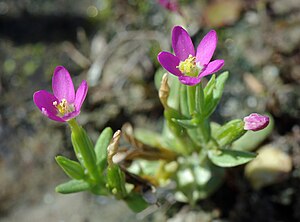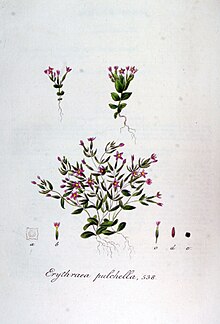Little centaury
| Little centaury | ||||||||||||
|---|---|---|---|---|---|---|---|---|---|---|---|---|

Lesser centaury ( Centaurium pulchellum ) |
||||||||||||
| Systematics | ||||||||||||
|
||||||||||||
| Scientific name | ||||||||||||
| Centaurium pulchellum | ||||||||||||
| ( Sw. ) Druce |
The Small centaury ( Centaurium pulchellum ), and Petite centaury called, is a flowering plant in the family of the Gentian family (Gentianaceae). It is common in Eurasia and North Africa.
description
The centaury is a dwarf, annual herbaceous plant that reaches heights of 2 to 15 centimeters. In contrast to the other centaury herbs native to Central Europe, the basal leaves do not form a rosette. The entire stem leaves are cross opposite . In the nominate form, the inflorescence is already forked in the lower areas. The main flowering time is from July to September. The five, rarely four-fold pink single flowers are up to 8 millimeters in size.
The number of chromosomes is 2n = 36.
ecology
The flowers only open at morning temperatures around 20 ° C or in sunshine and they close in the early evening at temperatures around 25 ° C. The plant has roots up to 15 centimeters deep.
Occurrence and endangerment
The centaury is found in almost all of Europe, it is only missing in the extreme north. It also occurs in West and Central Asia and in North Africa .
The centaury is naturally widespread in almost all of Europe, especially in coastal areas with the exception of northern Scandinavia, but the occurrence is inconsistent. In Central Europe it occurs scattered on the coasts of the North and Baltic Seas , in the limestone and clay areas it occurs only rarely, and then mostly in loose stands with few individuals. In the Central European mountains it hardly rises above an altitude of 100 meters. It occurs at altitudes of a good 800 meters.
It occurs in Central Europe scattered on sunny, fresh to alternately moist, often gravelly - sandy as well as calcareous or salty locations. Communitarised is Centaurium pulchellum often with species of dwarf bins companies . It colonizes waterlogging points on paths in open terrain, but also walks on steps on banks and beaches; it is not very sensitive to salt . In Central Europe, it occurs particularly in societies of the Nanocyperion association, but is a supra-regional type of character of the Isoeto-Nanojuncetea class.
The centaury thrives best on loamy , clayey , nutrient-rich and calcareous , compacted, alternately moist or wet soils .
The centaury is particularly protected in Germany .
Systematics
The valid name of the species Centaurium pulchellum (Sw.) Hayek can only be found correctly published by Hand.-Mazz. et al. in Oesterr. Bot. Z. 56:70. 1906. The publication by Druce is considered incorrect. Synonyms of Centaurium pulchellum ( Sw. ) Hayek are: Centaurium meyeri (Bunge) Druce , Erythraea morierei Corb. , Erythraea pulchella (Swartz) frieze .
One can distinguish the following subspecies:
- Centaurium pulchellum subsp. pulchellum
- Centaurium pulchellum subsp. meyeri (Bunge) Tzvelev : It occurs in Eastern Europe and North Africa.
- Centaurium pulchellum subsp. morierei (Corb.) P. Fourn. : It only occurs in France.
literature
- Otto Schmeil , Jost Fitschen (greeting), Siegmund Seybold: The flora of Germany and the neighboring countries. A book for identifying all wild and frequently cultivated vascular plants. 95th completely revised u. exp. Edition. Quelle & Meyer, Wiebelsheim 2011, ISBN 978-3-494-01498-2 .
- Oskar Sebald, Siegmund Seybold, Georg Philippi, Arno Wörz (eds.): The fern and flowering plants of Baden-Württemberg. Volume 5: Special part (Spermatophyta, subclass Asteridae): Buddlejaceae to Caprifoliaceae. Eugen Ulmer, Stuttgart 1996, ISBN 3-8001-3342-3
- Dietmar Aichele, Heinz-Werner Schwegler: The flowering plants of Central Europe . 2nd Edition. Volume 3, Franckh-Kosmos, Stuttgart 2000, ISBN 3-440-08048-X .
Individual evidence
- ↑ a b c Erich Oberdorfer : Plant-sociological excursion flora. Ulmer, Stuttgart, 1994. 7th edition ISBN 3-8252-1828-7 .
- ↑ a b c Erich Oberdorfer : Plant-sociological excursion flora for Germany and neighboring areas . With the collaboration of Angelika Schwabe and Theo Müller. 8th, heavily revised and expanded edition. Eugen Ulmer, Stuttgart (Hohenheim) 2001, ISBN 3-8001-3131-5 , pp. 752 .
- ^ A b Centaurium in the Germplasm Resources Information Network (GRIN), USDA , ARS , National Genetic Resources Program. National Germplasm Resources Laboratory, Beltsville, Maryland. Retrieved October 25, 2017.
- ↑ Centaurium pulchellum in the IUCN Red List of Threatened Species 2013.2. Posted by: RV Lansdown, MM Ali, 2012. Retrieved May 12, 2014.
- ↑ a b c Karol Marhold, 2011: Gentianaceae : Datasheet Centaurium pulchellum In: Euro + Med Plantbase - the information resource for Euro-Mediterranean plant diversity.
Web links
- Little centaury. In: FloraWeb.de.
- Little centaury . In: BiolFlor, the database of biological-ecological characteristics of the flora of Germany.
- Centaurium pulchellum (Sw.) Druce In: Info Flora , the national data and information center for Swiss flora . Retrieved January 22, 2016.
- Area map to Hultén.
- Thomas Meyer: Data sheet with identification key and photos at Flora-de: Flora von Deutschland (old name of the website: Flowers in Swabia )



